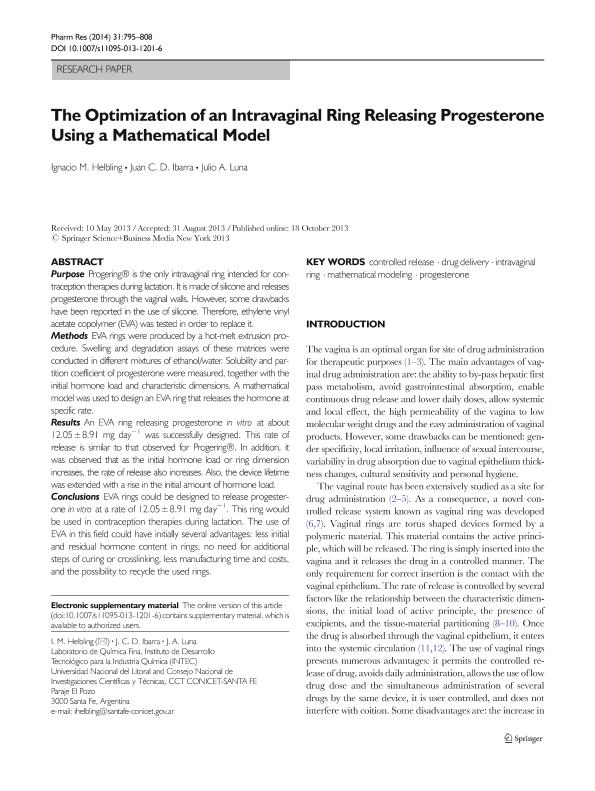Artículo
The optimization of an intravaginal ring releasing progesterone using a mathematical model
Fecha de publicación:
03/2014
Editorial:
Springer/plenum Publishers
Revista:
Pharmaceutical Research
ISSN:
0724-8741
Idioma:
Inglés
Tipo de recurso:
Artículo publicado
Clasificación temática:
Resumen
Purpose Progering® is the only intravaginal ring intended for contraception therapies during lactation. It is made of silicone and releases progesterone through the vaginal walls. However, some drawbacks have been reported in the use of silicone. Therefore, ethylene vinyl acetate copolymer (EVA) was tested in order to replace it. Methods EVA rings were produced by a hot-melt extrusion procedure. Swelling and degradation assays of these matrices were conducted in different mixtures of ethanol/water. Solubility and partition coefficient of progesterone were measured, together with the initial hormone load and characteristic dimensions. A mathematical model was used to design an EVA ring that releases the hormone at specific rate. Results An EVA ring releasing progesterone in vitro at about 12.05±8.91 mg day-1 was successfully designed. This rate of release is similar to that observed for Progering®. In addition, it was observed that as the initial hormone load or ring dimension increases, the rate of release also increases. Also, the device lifetime was extended with a rise in the initial amount of hormone load. Conclusions EVA rings could be designed to release progesterone in vitro at a rate of 12.05±8.91 mg day-1. This ring would be used in contraception therapies during lactation. The use of EVA in this field could have initially several advantages: less initial and residual hormone content in rings, no need for additional steps of curing or crosslinking, less manufacturing time and costs, and the possibility to recycle the used rings.
Archivos asociados
Licencia
Identificadores
Colecciones
Articulos(INTEC)
Articulos de INST.DE DES.TECNOL.PARA LA IND.QUIMICA (I)
Articulos de INST.DE DES.TECNOL.PARA LA IND.QUIMICA (I)
Citación
Helbling, Ignacio Marcelo; Ibarra, Juan Carlos Daniel; Luna, Julio Alberto; The optimization of an intravaginal ring releasing progesterone using a mathematical model; Springer/plenum Publishers; Pharmaceutical Research; 31; 3; 3-2014; 795-808
Compartir
Altmétricas




